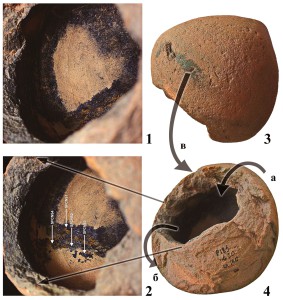 Ekaterina G. Devlet*, Alsu R. Nuretdinova**, Maksim V. Sivitskiy***
Ekaterina G. Devlet*, Alsu R. Nuretdinova**, Maksim V. Sivitskiy***
* Institute of Archaeology RAS, Moscow, Russia (eketek@yandex.ru)
** Kazan (Volga Area) Federal University, Russia (alsu.nuretdinova@rambler.ru)
*** A. Kh. Khalikov Institute of Archaeology of the Pepublic of Tatarstan, Kazan, Russia (M1213@mail.ru)
Keywords: Volga Bulgaria, Golden Horde, Bolgar, spheroconical vessels.
Spheroconical vessels have been studied for almost two centuries. Their specific shape generates diverse hypotheses of their function: they were treated as lamps, fire missiles, alchemic and medical-cosmetic containers, etc. This paper deals with the contents of a spheroconical vessel recovered from the excavations at Bolgar in 2013. Its neck is broken and the residue of its contents of dark brown, almost black colour can be seen on its inner wall while a burnt spot can be seen on the outer wall. The use of the vessel can be reconstructed; a small quantity of soft resin having thickened while held in storage was poured in it through the narrow neck. Later the contents was extracted probably after warming up the vessel lying on its side. Pouring out of a viscous substance left traces on the edge of the broken neck. The reconstruction is based on the analysis of stains and the data of scientific analyses enabling one to identify the dark substance as the heated soft resin of conifers. The number of intact spheroconical vessels is small and that of the items with reliably attributed contents even less. Up to this point the resin of conifers has never been encountered in spheroconical vessels, so the data acquired give an insight into their functions in medieval Islamic Orient.







